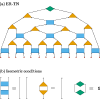Automatic structural search of tensor network states including entanglement renormalization
引用次数: 0
Abstract
Tensor network (TN) states, including entanglement renormalization (ER), can encompass a wider variety of entangled states. When the entanglement structure of the quantum state of interest is nonuniform in real space, accurately representing the state with a limited number of degrees of freedom hinges on appropriately configuring the TN to align with the entanglement pattern. However, a proposal has yet to show a structural search of ER due to its high computational cost and the lack of flexibility in its algorithm. In this study, we conducted an optimal structural search of TN, including ER, based on the reconstruction of their local structures with respect to variational energy. First, we demonstrated that our algorithm for the spin- tetramer singlets model could calculate exact ground energy using the multiscale entanglement renormalization ansatz (MERA) structure as an initial TN structure. Subsequently, we applied our algorithm to the random XY models with the two initial structures: MERA and the suitable structure underlying the strong disordered renormalization group. We found that, in both cases, our algorithm achieves improvements in variational energy, fidelity, and entanglement entropy. The degree of improvement in these quantities is superior in the latter case compared to the former, suggesting that utilizing an existing TN design method as a preprocessing step is important for maximizing our algorithm's performance.

张量网络状态的自动结构搜索,包括纠缠重正化
张量网络(TN)状态,包括纠缠重正化(ER),可以包含更多种类的纠缠状态。当感兴趣的量子态的纠缠结构在实空间中不均匀时,用有限的自由度准确地表示该态取决于适当地配置 TN 以与纠缠模式保持一致。然而,由于计算成本高、算法缺乏灵活性,目前还没有一项建议能显示出ER的结构搜索。在这项研究中,我们根据变异能重建 TN 的局部结构,对包括 ER 在内的 TN 进行了最优结构搜索。首先,我们证明了我们针对自旋-1/2 四聚体单子模型的算法可以使用多尺度纠缠重正化解析(MERA)结构作为初始 TN 结构,计算出精确的地能。随后,我们将算法应用于具有两种初始结构的随机 XY 模型:MERA和强无序重正化群基础上的合适结构。我们发现,在这两种情况下,我们的算法都实现了变分能量、保真度和纠缠熵的改进。与前者相比,后一种情况下这些量的改善程度更高,这表明利用现有的 TN 设计方法作为预处理步骤对于最大化我们算法的性能非常重要。
本文章由计算机程序翻译,如有差异,请以英文原文为准。
求助全文
约1分钟内获得全文
求助全文

 求助内容:
求助内容: 应助结果提醒方式:
应助结果提醒方式:


